
Hungarian cuisine is one of Europe’s most delightful—rich, spicy, smooth, and delicious. And Budapest specializes in trendy restaurants that mix Hungarian flavors with international flair, making the food here even tastier. Best of all, the prices are reasonable, especially if you venture off the main tourist trail. This is affordable sightseeing for your palate.
When restaurant-hunting, choose a spot filled with locals, not the place with the big neon signs boasting, “We Speak English and Accept Credit Cards.” Most restaurants have an English menu posted (or you can ask to see one). Any restaurant specializing in purely “traditional Hungarian food” is catering almost entirely to tourists. Locals prefer international-slash-Hungarian places, which is what I’ve emphasized in my listings.
If the place isn’t full, you can usually just seat yourself (get a server’s attention to be sure your preferred table is OK)—the American-style “hostess,” with a carefully managed waiting list, isn’t common here.
Once seated, feel free to take your time. In fact, it might be difficult to dine in a hurry. Only a rude waiter will rush you. Hungarian service is polite, but formal; don’t expect “Hi, I’m László and I’ll be your server—how you folks doin’ tonight?” chumminess. At traditional places, your tuxedoed server might bring your food to the table, bow with a formal click of the heels...then go back to the kitchen to apply more wax to his moustache. At any eatery, good service is deliberate (slow to an American).
An étterem (“eatery”) is a nice sit-down restaurant, while a vendéglő is usually more casual (similar to a tavern or an inn). A söröző (“beer place”) is a pub that sells beer and food, ranging from a small selection of snacks to a full menu. A kávéház (“coffeehouse”), or café, is where Budapesters gather to meet friends, get a caffeine fix...and sometimes to have a great meal. (I’ve listed my favorite cafés—including a few that are also some of Budapest’s best eateries—on here.) Other cafés serve only light food, or sometimes only desserts. But if you want a wide choice of cakes, look for a cukrászda (pastry shop—cukr means “sugar”).
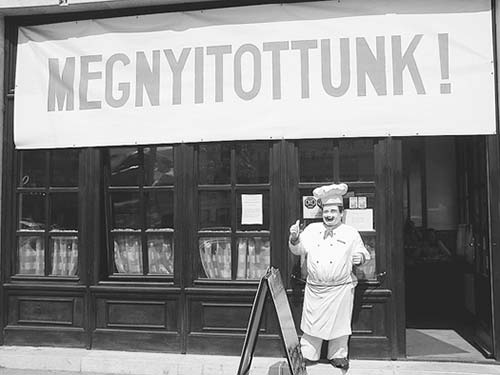
Ethnic restaurants provide a break from Hungarian fare (in the unlikely event you need one). Budapest has abundant vegetarian, Italian, Indian, Chinese, and other non-Hungarian eateries; I’ve listed my favorites. Once you leave the capital, the options are fewer, and the food gets even heartier and cheaper.
Occasionally, when you order a main course, it includes only the item itself (with no garnishes, side dishes, or starches). In these cases, you can order your choice of sides—listed on a separate page of the menu, and paid for separately. If you see a page listing these extras, ask the server if anything is included with your main dish.
Menus usually list drink prices by the tenth of a liter, or deciliter (dl), not by the glass; this is an honest and common practice, but can trip up visitors.
When the server comes to take your order, he might say “Tessék” (TEHSH-shayk), or maybe the more formal “Tessék parancsolni” (TEHSH-shayk PAW-rawn-chohl-nee)—“Please command, sir.” When they bring the food, they will probably say, “Jó étvágyat!” (yoh AYT-vah-yawt)—“Bon appétit.” When you’re ready for the bill, you can simply say, “Fizetek” (FEE-zeh-tehk)—“I’ll pay.”
At any restaurant, it’s smart to check the bill and count your change carefully. While most Hungarian restaurateurs are honest, rip-off joints abound in downtown Budapest’s tourist zone—especially along the main walking street, Váci utca. (Frankly, I’d never eat on Váci utca, which practically guarantees bad food and service for high prices.) Avoid any place with a menu that doesn’t list prices, and tune in to the fine print (such as the service charge—explained next).
Hungarians tip less than Americans do. Most restaurants in Budapest automatically add a 10 percent service charge to the bill. (A few of the more tourist-oriented eateries have nudged this up to 12 or even 15 percent, which Hungarian diners consider excessive.) The extra charge should be noted on the menu (if it’s not, complain), and appears as a line item after the subtotal on the bill (look for “service,” “tip,” felszolgálási díj, or szervízdíj). In these cases, an additional tip is not necessary for adequate service.
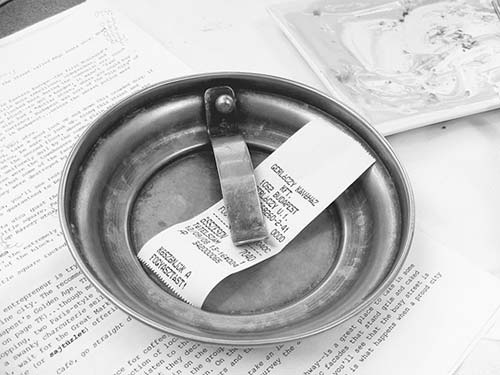
If the service fee is not included, waiters expect a tip of about 10 percent (or a little less; more than 10 percent is reserved for exceptional service).
For more on tipping, see here.
Most Eastern Europeans dine on a starchy meat-and-potatoes cuisine to maximize calories and carbs through a harsh winter. But, as with many things, Hungary is different. Hungarians don’t just eat to live—they live to eat. This makes Hungarian cuisine the undisputed best in Central Europe. It delicately blends Magyar peasant cooking (with rich spices), refined by the elegance of French preparation, with a delightful smattering of flavors from the vast, multiethnic Austro-Hungarian Empire (including Germanic, Balkan, Jewish, and Carpathian). Everything is heavily seasoned: with paprika, tomatoes, and peppers of every shape, color, size, and flavor.
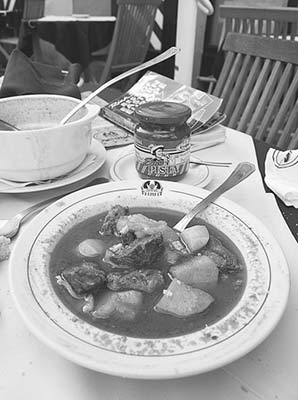
When foreigners think of Hungarian cuisine, what comes to mind is goulash. But tourists are often disappointed when “real Hungarian goulash” isn’t the thick stew that they were expecting. The word “goulash” comes from the Hungarian gulyás leves, or “shepherd’s soup”—a tasty, rustic, nourishing dish originally eaten by cowboys and shepherds on the Great Hungarian Plain. Here in its homeland, it’s a clear, spicy broth with chunks of meat, potatoes, and other vegetables. Elsewhere (such as in the Germanic and Slavic countries that are Hungary’s neighbors), the word “goulash” does describe a thick stew. The hearty Hungarian stew called pörkölt is probably closer to what most people think of as goulash.
Aside from the obligatory gulyás, make a point of trying another unusual Hungarian specialty: cold fruit soup (hideg gyümölcs leves). This sweet, cream-based treat—generally eaten before the meal, even though it tastes more like a dessert—is usually made with meggy (sour cherries), but you’ll also see versions with alma (apples) or körte (pears). Other Hungarian soups (levesek) include bableves (bean soup), zöldségleves (vegetable soup), gombaleves (mushroom soup), halászlé (fish broth with paprika), and húsleves (meat or chicken soup). The ultimate staple of traditional Hungarian home-cooking, but rarely served in restaurants, is főzelék—a simple but tasty wheat flour-thickened stew that can be supplemented with various vegetables and meats (served at cheap restaurants around Budapest—see the Főzelékfaló Ételbár listing on here).
Hungarians adore all kinds of meat. Hús or marhahús is beef, csirke is chicken, borjú is veal, kacsa is duck, liba is goose, sertés is pork, sonka is ham, kolbász is sausage, szelet is schnitzel (Bécsi szelet means Wiener schnitzel)—and the list goes on. One trendy ingredient you’ll see on menus is mangalica. This uniquely Hungarian, free-range woolly pig (basically a domesticated boar) is high in unsaturated fat—which fits perfectly with the current foodie culture that elevates the mighty pig. Libamáj is goose liver, which shows up everywhere (anything prepared “Budapest style” is topped with goose liver). Lard is used extensively in cooking, making Hungarian cuisine very rich and filling.
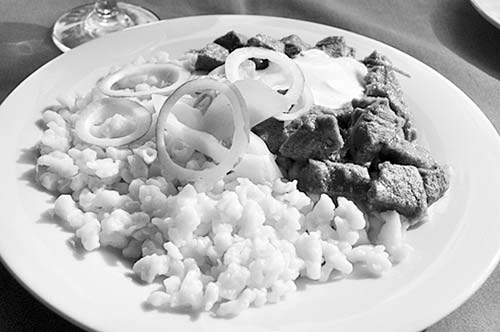
Meat is often covered with delicious sauces or garnishes, from rich cream sauces to spicy pastes to fruit jam. For classic Hungarian flavors, you can’t beat chicken or veal paprikás (described in the “Paprika Primer” sidebar).
Vegetarians have a tricky time in traditional Hungarian restaurants, many of which offer only a plate of deep-fried vegetables. A traditional Hungarian “salad” is composed mostly or entirely of pickled vegetables (pickles, cabbage, peppers, and others); even many modern restaurants haven’t quite figured out how to do a good, healthy, leafy salad. Fortunately, the more modern, trendy eateries in the capital often offer excellent vegetarian options.
Starches (köretek)—which you’ll sometimes order separate from the meat course—can include nokedli (small potato dumplings, a.k.a. Spätzle), galuska (noodles), burgonya (potatoes), krumpli (French fries), krokett (croquettes), or rizs (rice). Kenyér (bread) often comes with the meal. A popular snack—especially to accompany a wine-tasting—is a pogácsa, a deep-fried savory doughnut.
Sometimes your main dish will come with steamed, grilled, or deep-fried vegetables. A common side dish is káposzta (cabbage, often prepared like sauerkraut). You may also see töltött káposzta (cabbage stuffed with meat) or töltött paprika (stuffed peppers). Lescó (LEH-chew) is the Hungarian answer to ratatouille: a richly flavorful stew of tomatoes, peppers, and other vegetables.
Thin, crêpe-like pancakes (palacsinta) are sometimes served as a main dish. A delicious traditional Hungarian dish is Hortobágyi palacsinta (Hortobágy pancakes, named for the Hungarian Great Plain where the dish originates). This is a savory crêpe wrapped around a tasty meat filling and drenched with creamy paprika sauce.
Pancakes also appear as desserts, stuffed and/or covered with fruit, jam, chocolate sauce, walnuts, poppy seeds, or whipped cream. Most famous is the Gundel palacsinta, named for the top-of-the-line Budapest restaurant—stuffed with walnuts and raisins in a rum sauce, topped with chocolate sauce, and flambéed.
Pastries are a big deal in Hungary. In the late 19th century, pastry-making caught on here in an attempt to keep up with the renowned desserts of rival Vienna. Today Hungary’s streets are still lined with cukrászda (pastry shops) where you can simply point to whichever treat you’d like. Try the Dobos torta (a many-layered chocolate-and-caramel cream cake), somlói galuska (a dumpling with vanilla, nuts, and chocolate), anything with gesztenye (chestnuts), and rétes (strudel with various fillings, including túrós, curds). And many cukrászda also serve fagylalt (ice cream, fagyi for short), sold by the gomboc (ball).
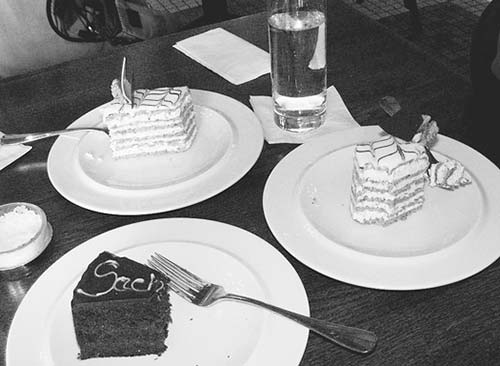
Kávé (KAH-vay) and tea (TEH-aw) are coffee and tea. (Confusingly, tej is not tea—it’s milk.) As for water (víz, veez) it comes as szódavíz (soda water, sometimes just carbonated tap water) or ásványvíz (spring water, more expensive).
Hungary is first and foremost a wine country. For the complete rundown on Hungarian wines, see the next section.
Hungary isn’t particularly well-known for its beer (sör, pronounced “shewr”), but Dreher and Borsodi are two of the better brands. Villagos is lager; if you prefer something darker, look for barna (brown).
Hungary is almost as proud of its spirits as its wines. The local firewater, pálinka, is a powerful schnapps made from various fruits (most often plum, szilva; or apricots, barack). Also look for the pear-flavored Vilmos brandy.
Unicum is a unique and beloved Hungarian bitter liquor made of 40 different herbs and aged in oak casks. Look for the round bottle with the red cross on the label. The flavor is powerfully unforgettable—like Jägermeister, but harsher. Unicum started out as a medicine and remains a popular digestif for easing an upset stomach (especially if you’ve eaten too much rich food—not an uncommon problem in Hungary). Purists claim it’s better to drink it at room temperature (so you can fully appreciate its bouquet), but novices find it easier to slug back when chilled. If the original Unicum overwhelms your palate, try one of the newer variations: Unicum Next, with more of a citrus flavor, and Unicum Szilva (with a golden plum on the label), which is aged in plums that cut some of the bitterness with a rich sweetness (www.zwack.hu). For more on the epic story behind Unicum, see here.
If you’re drinking with some new Magyar friends, impress them with the standard toast: Egészségedre (EH-gehs-shay-geh-dreh; “to your health”).
Wine (bor) is an essential part of Hungarian cuisine. Grapes have been cultivated here since Roman times, and Hungarian wines had an excellent reputation (winning raves from the likes of France’s King Louis XIV and Ludwig von Beethoven) up until World War II. Under communism, most vineyards were collectivized, and the quality suffered terribly. But since the end of that era, many wine-growing families have reclaimed their property and gone back to their roots (literally). Today they’re attempting to resuscitate the reputation of Hungarian wines. They’re off to a great start.
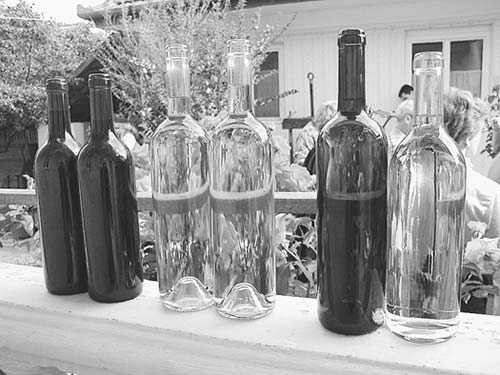
Hungary boasts 22 designated wine-growing regions. The area around Eger is the most famous, but that’s only the beginning. The Villány Hills south of Pécs—with a semi-Mediterranean climate at the same latitude as Bordeaux, France—produce full-bodied, tannic reds. The Sopron region near the Austrian border produces both reds and whites. (Northern reds like these tend to be fruity and light.) The hillsides above Lake Balaton (west of Budapest) and the Szekszárd area (along the Danube in southern Hungary) also produce well-respected wines.
Whites (fehér) can be sweet (édes), half-dry (félszáraz), or dry (száraz). Whites include the standards (riesling, chardonnay), as well as some wines made from more typically Hungarian grapes: leányka (“little girl”), a half-dry, fairly heavy, white table wine; cserszegi fűszeres, a spicy, light white that can be fruity; the half-dry, full-bodied hárslevélű (“linden leaf”); and the dry furmint and kéknyelű (“blue stalk”).
Reds (vörös) include the familiar varieties (cabernet sauvignon, cabernet franc, merlot, pinot noir), and some that are less familiar. Kekporto is better known as blauer Portugieser in German-speaking countries. In Eger, don’t miss Bull’s Blood, a.k.a. Egri Bikavér, a distinctive blend of reds that comes with a fun local legend (described on here). The spicy, medium-body kékfrankos (“blue Frankish”) supposedly got its name because when Napoleonic soldiers were here, they could pay either with valuable blue-colored bank notes or unstable white ones...and local vintners wanted the blue francs. (Like most wine origin legends, this story is untrue—kékfrankos wasn’t cultivated here until after Napoleon’s time.)
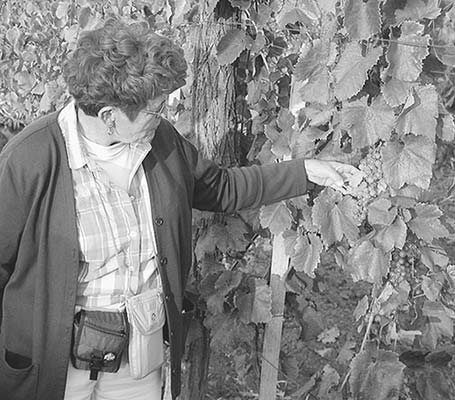
Probably the most famous Hungarian wine is Tokaji Aszú, a sweet, late-harvest, honey-colored dessert wine made primarily from furmint grapes. Known as the “wine of kings, and the king of wines,” Tokaji Aszú is a D.O.C. product, meaning that to have that name, it must be grown in a particular region. Tokaj is a town in northeastern Hungary, while aszú is a “noble rot” grape. The wine’s unique, concentrated flavor is made possible by a fungus (Botrytis cinerea) that thrives on the grapes in the late fall. The grapes are left on the vine, where they burst and wither like raisins before they are harvested in late October and November. This sucks the water out of the grape, leaving behind very high sugar content and a deep golden color. Tokaji Aszú wines are numbered, from three to six, indicating how many eight-gallon tubs (puttony) of these “noble rot” grapes were added to the base wine—the higher the number, the sweeter the wine. Other variations on Tokaji can be less sweet. (This might sound like another bizarre Hungarian custom, but the French Sauterne and German Beerenauslese wines are also made from “noble rot” grapes. The similarly named French Tokay wine—which derives from the same word—is a different story altogether.)
Finally, note that, except for Bull’s Blood and Tokaji Aszú, Hungarian wines are not widely available in the US. Packing home a bottle or two (in your checked luggage) is a unique souvenir.
Thanks to Budapest’s ever-evolving culinary scene, there’s no shortage of places to dine. I can barely keep track of what’s new—and scouting new restaurants is the highlight of my research chores. The broad range of options and healthy sense of one-upmanship among local chefs keep prices reasonable and quality high. The foodie scene here is boom-and-bust: A place quickly acquires a huge and enthusiastic following, but soon falls from grace as an even more enticing competitor opens up shop.
While you’ll find the standard Hungarian fare, most big-city restaurants like to dabble in international cuisine. Many of my listings feature an international menu with some Hungarian flourishes. (If you want truly traditional Hungarian fare, you’ll actually do better in smaller towns.) The good news: Most Hungarian chefs are so skilled that any cuisine is well-executed here.
Most Hungarians dine between 19:00 and 21:00, peaking around 20:00; trendy zones such as St. István Square and Franz Liszt Square, which attract an after-work crowd, are lively earlier in the evening.
Lunch Specials: Many Budapest restaurants offer lunch specials, called napimenü, on weekdays. As these are designed for local office workers on their lunch breaks rather than for tourists, they’re often not advertised in English—but if you see the magic word napimenü, ask about it. Even at trendy, otherwise pricey eateries, you’ll generally pay around 1,000 Ft for a fixed menu (soup and main dish or main dish and dessert; no choices—take it or leave it).
(See "Pest Town Center Hotels & Restaurants" map, here.)
I’ve listed these options by neighborhood, for easy reference with your sightseeing.
(See "Pest Town Center Hotels & Restaurants" map, here.)
When you ask natives about good places to eat on Váci utca, they just roll their eyes. Budapesters understand that only rich tourists who don’t know better would throw their money away on the relatively bad food and service along this high-profile pedestrian drag. But wander a few blocks off the tourist route, and you’ll discover alternatives with fair prices and better food. For locations, see the map on here.
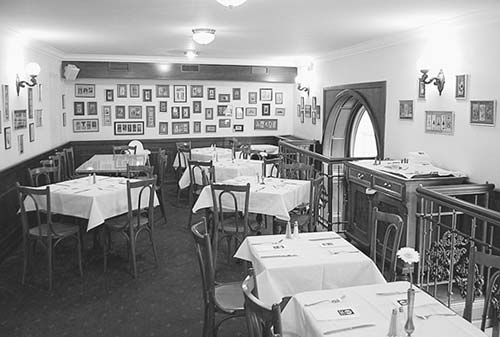
Gerlóczy Café is tucked on a peaceful little square next to the giant City Hall. This classy café features French, Hungarian, and international cuisine with several seating options (out on the square, in the coffee-house interior, or upstairs). There’s a good permanent menu, plus changing specials (Friday is fish day). The clientele is a mix of tourists and upscale-urban Budapesters, including local politicians and actors from several nearby theaters. With a take-your-time ambience that’s arguably more Parisian than Hungarian—and with live harp or piano music inside from 19:00 to 23:00—this is a particularly inviting spot (3,000-5,000-Ft main dishes, 1,900-Ft two-course or 2,500-Ft three-course lunch specials available Mon-Thu, good breakfasts, fresh-baked pastries and bread, daily 7:00-23:00, 2 blocks from Váci utca, just off Városház utca at Gerlóczy utca 1, district V, M3: Ferenciek tere, tel. 1/501-4000). They rent good rooms, too (see here).
Halkakas Halbisztró (“Fishrooster Fish Bistro”) is a tight, tidy, cheery, colorful French-style bistro serving up mostly Hungarian fish with a variety of sauces. In this landlocked country, that means freshwater fish (catfish, pikeperch, trout, and so on)—better than it sounds, and very local (1,600-2,000-Ft main dishes, Mon-Sat 12:00-22:00, closed Sun, Veres Pálné utca 33, mobile 0630-226-0638).
Borssó Bistro, in the newly spiffed-up area near University Square (Egyetem tér), is a trendy eatery offering small portions of delicately assembled modern French cuisine with a bit of Hungarian flair. The cozy two-story interior’s ambience, like the cuisine, is an elegant yet accessible blend of old and new. They also have outdoor tables and occasional live music. Reservations are important at this pricey, popular place (3,600-5,000-Ft main dishes, Tue 18:00-23:00, Wed-Sun 12:00-23:00, closed Mon, Király Pál utca 14, district V, M3/M4: Kálvin tér, tel. 1/789-0975, mobile 0620-807-7087).
BorLabor (“Wine Lab”) features traditional, regional, updated Hungarian specialties at reasonable prices in a warm, mod, romantic wine-cellar atmosphere. It’s not as trendy as many other Budapest eateries...but that’s the point (2,500-3,000-Ft main dishes, daily 12:00-24:00, a block north of Váci utca at Veres Pálné utca 7, district V, M3: Ferenciek tere, tel. 1/328-0382).

Great Market Hall: At the far south end of Váci utca, you can eat a quick lunch on the upper floor of the Great Market Hall (Nagyvásárcsarnok). Fakanál Étterem—the glassed-in, sit-down cafeteria above the main entrance—is touristy, but offers good seating (2,000-3,200-Ft main dishes, Mon-Fri 10:00-17:00, Sat 10:00-14:00, closed Sun; live music most days 12:00-15:00). The sloppy, stand-up stalls along the right side of the building are cheaper, but quality can vary (grab a bar stool or you’ll stand while you munch). Locals love the Lángos stand for deep-fried bread slathered with sour cream and cheese (add garlic for some kick). Or you can assemble a picnic—produce and butcher stands line the main floor, and an Aldi supermarket is in the basement (the end nearest Váci utca; market hall open Mon 6:00-17:00, Tue-Fri 6:00-18:00, Sat 6:00-15:00, closed Sun; supermarket open longer hours, Fővám körút 1-3, district IX, M4: Fővám tér).
Ráday Utca: This mostly pedestrianized street is lined with a variety of cafés and restaurants, mostly catering to tourists and specializing in big portions of listlessly executed traditional Hungarian fare. But while its trendy heyday has largely passed, Ráday utca is still a marginally better alternative to the tourist traps along nearby Váci utca. To reach Ráday utca, take the M3/blue or M4/green Metró line to Kálvin tér—a five-minute walk from the Great Market Hall—and head south (district IX). For something a bit better than the rest, stop by Café Intenzo, hiding around the corner from the start of Ráday utca, where it meets the busy ring road. Low-key and with a loyal local following, they serve Hungarian and international cuisine, either in a nondescript interior or out in a pleasant courtyard garden (1,400-Ft sandwiches, 1,700-2,000-Ft pastas, 2,000-4,000-Ft main dishes, Mon-Fri 11:00-24:00, Sat-Sun 12:00-23:00, Kálvin tér 9, tel. 1/219-5243).
(See "Pest Town Center Hotels & Restaurants" map, here.)
The riverbank facing the castle is lined with hotel restaurants and permanently moored restaurant boats. You’ll find bad service, mediocre food, mostly tourists, and sky-high prices...but the atmosphere and people-watching are enticing.
For a more affordable and more local experience, head a bit farther south, near the green Liberty Bridge. Along the embankment road called Belgrád Rakpart is a cluster of fun and lively ethnic restaurants (including good Italian at Trattoria Toscana, #13, and a mini-Santorini with Greek fare at Taverna Dionysos, #16).
Various companies run dinner cruises along the Danube, including Legenda (see here) and Hungária Koncert (see here), both of which offer a discount to Rick Steves readers. While these can be romantic, Budapest’s real restaurants are too tempting to pass up. Instead, dine at your choice of eateries, then take the Legenda nighttime cruise.
(See "Pest Town Center Hotels & Restaurants" map, here.)
The streets in front of St. István’s Basilica are jammed with upscale, dressy, yuppie-oriented eateries. You could simply browse the options along Zrínyi utca (which stretches straight down to the Danube from the basilica’s front door) and its cross streets. But the following choices are worth seeking out. For locations, see the map on here.
Café Kör (“Circle”) has long been a mainstay in this fast-emerging zone. This stylish but unsnooty eatery serves up mostly Hungarian and some Mediterranean fare in a tasteful, tight one-room interior and at a few sidewalk tables. It prides itself on being friendly and providing a good value. Because it’s beloved by local foodies, reservations are smart anytime—and essential on weekends (2,000-4,000-Ft main dishes, small portions for 30 percent less, good salads, daily specials, cash only, Mon-Sat 10:00-22:00, closed Sun, Sas utca 17, district V, between M3: Arany János utca and M1: Bajcsy-Zsilinszky út, tel. 1/311-0053).
Mák Bistro is pricey but unpretentious, with a loyal local following (reservations are smart, especially on weekends). It feels like a well-kept secret, tucked down a forgotten side street parallel to the bustling Zrínyi utca main drag. Inside, it has a lively brasserie ambience under white-painted brick vaults. The short, carefully selected seasonal menu is based on what’s fresh (5,500-7,500-Ft main courses, Tue-Sat 12:00-15:00 & 18:00-23:00, closed Sun-Mon, Vigyázó Ferenc 4, mobile 0630-723-9383, www.mak.hu).
Wine-Focused Eateries: Two wine bars—one casual, the other upscale—have helped turn this neighborhood into a happening nightspot. DiVino is all about the wine, serving 130 different types of exclusively Hungarian wines, listed by region on the chalkboard—all of them available either by the glass or by the bottle. The well-versed staff can help introduce you to Hungary’s underrated wines—just tell them what you like and let them guide you to something to try. While DiVino doesn’t do flights or “tastings” per se, couples are invited to share glasses to try several varieties. The interior has a hip black-chalkboard atmosphere, and there’s also very inviting seating out on the square (many glasses affordable at around 600-1,000 Ft, also 1,300-2,500-Ft meals, daily 16:00-24:00, later on weekends, St. István tér 3, mobile 0670-935-3980; they also have another, bigger location in the Gozsdu Udvar passage in the Jewish Quarter). Just around the corner, Borkonyha (“Winekitchen”) focuses both on its list of high-quality (and pricey) Hungarian wines, and on its modern Hungarian cuisine (“Hungarian dishes—but less paprika, less fat”). Because they’re enthusiastic about their wines, they sell even pricey bottles by the glass (about 45 types—700-3,000 Ft per glass). The menu—especially the adventurous chalkboard specials—ventures into “nose-to-tail” cooking, using ingredients you won’t find everywhere. The decor is sophisticated black, white, and gold—it’s a dressy place where wine snobs feel at home. As this place has received a lot of international press, reservations are smart (3,800-4,200-Ft main dishes, Mon-Sat 12:00-24:00, closed Sun, Sas utca 3, tel. 1/266-0835, www.borkonyha.hu).
Behind St. István’s Basilica: Belvárosi Lugas Étterem is your cheap-and-charming, no-frills option. Lugas is a Hungarian word for a welcoming garden strewn with grape vines, and the cozy dining room—with a dozen tables of happy eaters under overhanging vines—captures that spirit. Or sit at one of their sidewalk tables outside on busy Bajcsy-Zsilinszky. The food is simply good Hungarian (1,500-3,200-Ft main dishes, order starches separately, daily 12:00-23:30, directly behind and across the street from St. István’s Basilica at Bajcsy-Zsilinszky út 15, district VI, M1: Bajcsy-Zsilinszky út, tel. 1/302-5393).
Homemade Strudel: Első Pesti Rétesház is a favorite among fans of rétes (strudel). Step inside to watch them roll out the long, paper-thin sheets of dough, then wrap them around a variety of fillings. Get a 300-Ft piece to go at the takeaway counter, or sit and enjoy your rétes with a cup of coffee (also has a full food menu, daily 9:00-23:00, Október 6 utca 22, tel. 1/428-0134).
(See "Andreassy Út Hotels & Restaurants" map, here.)
Some of Budapest’s best eateries are in this area—a hotbed for capable chefs and restaurateurs. For locations, see the map on here.
Franz Liszt Square (Liszt Ferenc Tér): Franz Liszt Square, a leafy park on the most interesting stretch of Andrássy út, boasts a stylish cluster of pricey, pretentious, yuppie restaurants, many with outdoor seating (lively on a summer evening; most places have main dishes around 3,000-5,000 Ft). My favorite Liszt Square eatery, Menza (the old communist word for “School Cafeteria”), wins the “Best Design” award. Recycling 1970s-era furniture and an orange-brown-gray color scheme, it’s a postmodern parody of an old communist café—half kitschy-retro, half contemporary-stylish. When old-timers come in here, they can only chuckle and say, “Yep. This is how it was.” With tasty and well-priced updated Hungarian and international cuisine, embroidered leather-bound menus, brisk but efficient service, breezy jazz on the soundtrack, and indoor or outdoor seating, it’s a memorable spot (2,300-3,500-Ft main dishes, daily 10:00-24:00, halfway up Andrássy út at Liszt Ferenc tér 2, district VII, tel. 1/413-1482, www.menza.co.hu). If you like the Franz Liszt Square scene, you’ll find a similar energy on Kertész utca beyond the end of the square, and in the “Broadway Quarter” near the Opera House (on Hajós utca and Nagymező utca).
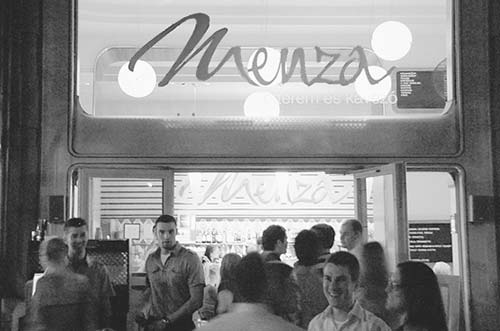
Right on Andrássy út: Klassz is a trendy bistro with a similarly postmodern “eclectic-mod” aesthetic, both in its decor and its food. Serving surprisingly affordable international/nouvelle cuisine with Hungarian flair, it’s a favorite among Budapest’s value-seeking foodies (1,900-4,600-Ft main dishes, daily 11:30-22:30, Andrássy út 41, district VI, between M1: Opera and M1: Oktogon, no reservations possible).
In the “Broadway Quarter”: Pesti Disznó (“Pest Pig”), set right along the liveliest stretch of theaters in town, is dedicated to serving delicious and surprisingly affordable food that celebrates Hungarian pork: the prized hairy pig called mangalica. The menu ranges from well-executed Hungarian classics to international fare to creative fusion dishes—like a mangalica hamburger. While the interior, with tall tables surrounding the open kitchen, is fine, I’d rather sit out under the red-and-white striped awnings facing the bright lights of Budapest’s theater scene (2,000-3,500-Ft main dishes, daily 11:00-24:00, Nagymező 19, tel. 1/951-4061).
On the Great Boulevard: Bock Bisztró, run by a prominent Hungarian vintner from Villány, offers traditional Hungarian staples presented with modern flourish—almost “deconstructed” but still recognizable. The ambience is that of an unpretentious wine bar, with cork-filled tables. Pricey and well-regarded, with 250 different wines on the menu (including 60 by the glass), it’s a good opportunity to sample food and wine from around the country. The service can be a bit stuffy, but the food lives up to its reputation. Reservations are essential (3,700-4,700-Ft main dishes, Mon-Sat 12:00-24:00, closed Sun, in the Corinthia Grand Royal Hotel, a couple of blocks west of the Oktogon on the Great Boulevard, Erzsébet körút 43-49, district VII, M1: Oktogon, right by Király utca stop on trams #4 and #6, tel. 1/321-0340, http://bockbisztropest.hu).
On Nagymező utca: Két Szerecsen (“Two Saracens”), named for a historic coffee shop at this location a century ago that a trader filled with exotic goods, features eclectic and well-executed international cuisine—including Mediterranean and Asian. With good indoor and outdoor seating, reasonable prices, and relatively small portions, it’s a reliable choice (1,600-2,000-Ft pastas and salads, 2,200-3,800-Ft main dishes, daily 9:00-24:00, a block off Andrássy út at Nagymező utca 14, district VI, M1: Opera, tel. 1/343-1984).
Italian: Millennium da Pippo, run by a Sicilian who speaks only Italian, greets you with a robust “Buona sera!” A neighborhood favorite for pasta and pizza, it’s a handy choice near the House of Terror (1,900-2,800-Ft pizza and pastas, daily 12:00-24:00, Andrássy út 76, district VI, M1: Vörösmarty utca, tel. 1/374-0880).
Indian: Hungarians seem to have an affinity for Indian cuisines, which, like Hungarian cuisine, smooth together powerful spices. Shalimar’s high-ceilinged, nondescript dining room hides in a dreary neighborhood two blocks beyond the end of Franz Liszt Square. Everything about this place is unexceptional...except the food, which is my favorite for a break from pork and kraut. I can never resist the murg makhani...and I’m never disappointed (1,600-3,000-Ft main dishes, half-portions 40 percent less, daily 11:30-16:00 & 18:00-23:00, Dob utca 33, district VII, between M1: Oktogon and M2: Blaha Lujza tér, tel. 1/352-0305).
(See "Andreassy Út Hotels & Restaurants" map, here.)
Along with the rise of “ruin pubs” (see here), Budapest’s Jewish Quarter has seen the arrival of several good restaurants in recent years. While some of these feature Jewish food (either kosher or updated), others are more eclectic, catering to a younger clientele. As this is a fast-emerging scene, you could just explore here. The following are some reliably good options. For locations, see the maps on here and here.
Macesz Huszár is a grandma’s-dining-room-cozy corner restaurant serving traditional Jewish recipes with modern attention to ingredients and technique. It’s a good value and has quickly gained a loyal following, so reserve ahead (2,300-3,500-Ft main courses, daily 11:30-24:00, Dob utca 26, tel. 1/787-6164, www.maceszhuszar.hu).
Kőleves (“Stone Soup”) runs a ruin-pub garden, but their restaurant feels upscale and put-together without being stuffy. The eclectic, international menu includes several Jewish (though not kosher) dishes. This is a good place to try if Macesz Huszár (listed above) is full (2,000-3,600-Ft main dishes, daily 12:00-24:00, Kazinczy utca 41, mobile 0620-213-5999).
Soul Food is a casual Cajun and creole-inspired eatery run by Attila, who’s a well-traveled singer by profession and a chef by passion. It feels like a creative college dive: Create your own rice or noodle bowl, or order a sandwich or burger (1,300-1,800-Ft meals, daily 12:00-23:00, later on weekends, takeaway also available, Kazinczy utca 32, mobile 0670-313-8804).
(See "City Park Walk" map, here.)
I wouldn’t go out of my way to eat in City Park, but if you’re enjoying a day here and would like a scenic meal, Robinson is a good option. For the location, see the map on here.
Robinson, stranded on an island in City Park’s lake, is a hip, playful, mellow theme restaurant. With island-castaway ambience and more outdoor seating than indoor, it’s made to order for lazing away a sunny afternoon at the park. The terrace and elegant, glassed-in dining room feature pricey international and Hungarian cuisine, and upstairs is a swanky steak house. In good weather, I’d come here for the terrace, to just sip a coffee or have a slice of cake (3,500-Ft pastas, 4,000-5,000-Ft main dishes, daily 11:00-17:00 & 18:00-23:00, reserve ahead and ask for lakefront seating, Városligeti tó, district XIV, M1: Hősök tere, tel. 1/422-0222).
For something quicker and more casual, closer to the end of the lake, look for the BRGR burger stand.
(See "Buda Hotels & Restaurants" map, here.)
Eateries on Castle Hill are generally overpriced and touristy—as with Váci utca, locals never eat here. The Víziváros (“Water Town”) neighborhood, between the castle and the river, is a bit better. Even if sleeping in Buda, try to dine in Pest—that’s where you’ll find the city’s best restaurants. All of the restaurants listed here (except Szent Jupát) are in district I. For locations, see the map on here.
(See "Buda Hotels & Restaurants" map, here.)
If you must eat atop Castle Hill, and just want a quick bite, visit the handy, affordable CBA grocery store (Mon-Fri 7:00-20:00, Sat 8:00-20:00, Sun 9:00-18:00).
For coffee and cakes, try the historic Ruszwurm (described later, under “Budapest’s Café Culture”). If you’d rather have a meal—and don’t want to head down to Víziváros—try the following choices:
Vár Bistro is a convenient, affordable cafeteria that makes for an easy and quick way to grab a meal between sightseeing; best of all, it has delightful outdoor seating overlooking a pretty park (1,000-2,500-Ft main dishes, 1,300-Ft “tourist menu” main dish and soup combo available at lunch, open daily 8:00-20:00, Dísz tér 8, mobile 0630-237-0039).
21 Magyar Vendéglő (“21 Hungarian Kitchen”) features traditional Hungarian fare that’s updated for the 21st century (hence the name). While the mod interior is pleasant, it’s also fun to sit out on pretty Fortuna utca (near the north end of the hill). Most restaurants on Castle Hill are overpriced, and this is no exception—but the quality is also good. This is a rare castle-zone eatery that really takes pride in its food rather than being a crank-’em-out tourism machine (2,300-3,800-Ft light meals, 3,500-5,400-Ft bigger meals, chalkboard specials, daily 11:00-24:00, Fortuna utca 21, tel. 1/202-2113).
Baltazár, near the ruins of St. Mary Magdalene Church (a few short blocks from the main sights), is singlehandedly trying to inject some youthful liveliness into the staid, sleepy north end of Castle Hill. It’s a fun choice, with bright, brash decor, pleasant outdoor seating, and a wood-fired charcoal grill that churns out smoky dishes. They also have an inviting beer garden just up the street, under the church tower (2,700-3,800-Ft main dishes, daily 7:30-24:00, Országház utca 31, tel. 1/300-7050).
(See "Buda Hotels & Restaurants" map, here.)
This bustling square—the transportation hub for Víziváros—is overlooked by a recently renovated, late-19th-century market hall (today housing a big Spar supermarket and various shops). Several worthwhile, affordable eateries—nothing fancy, just practical—cluster around this square. Survey your options before settling in.
Nagyi Palacsintázója (“Granny’s Pancakes”)—just to the right of the market hall entrance—serves up cheap and tasty crêpes (palacsinta) to a local crowd (200-400-Ft sweet or savory small crêpes—order more than one for a filling meal, ask for English menu, open 24 hours daily, Batthyány tér 5).
As you face the market hall, go up the street that runs along its left side (Markovits Iván utca) to reach more good eateries: At the end of the block on the right is Édeni Végan, a self-service, point-and-shoot vegetarian cafeteria (main dishes less than 1,000 Ft, daily 8:00-20:00, tel. 1/375-7575). And tucked behind the market hall is Bratwursthäusle/Kolbászda, a fun little beer hall/beer garden with Bavarian specialties and blue-and-white checkerboard decor to match. Sit outside, or in the woody interior (900-1,200-Ft sausages, daily 11:00-23:00, Gyorskocsi utca 6, tel. 1/225-3674).
Fine Dining near Batthyány Tér: Csalogány 26 is a stylish, upscale bistro a few short blocks from Batthyány tér in an otherwise dull urban neighborhood. Its modern international cuisine, served in a classy contemporary dining room, has earned it raves as one of the best eateries in this part of town. You can order à la carte (2,600-5,000-Ft main dishes), or go for one of their menus: 9,000 Ft/four courses, 13,000 Ft/eight courses (Tue-Sat 12:00-15:00 & 19:00-22:00, closed Sun-Mon, Csalogány utca 26, tel. 1/201-7892, www.csalogany26.hu).
(See "Pest Town Center Hotels & Restaurants" map, here.)
When you’re in the mood for something halfway between a restaurant and a picnic meal, look for takeout food stands, bakeries (with sandwiches to go), grocers willing to make you a sandwich, and simple little eateries for fast and easy sit-down restaurant food.
A popular snack is lángos—a savory deep-fried doughnut (similar to an elephant ear or Native American fry bread). Sold at stands on the street, the most typical versions are spread with cheese and sour cream, and sometimes topped with garlic. Some restaurants serve a fancier version (often with meat) as an entrée. The Lángos stand upstairs in the Great Market Hall is a local favorite (see here).
For quick, inexpensive, and very local grub, head for the chain called Főzelékfaló Ételbár (roughly, “Soup Slurper Eating Bar”). This self-service cafeteria dishes up simple fare to businesspeople on their lunch break. Főzelék, a simple soup that’s thickened with roux (wheat flour mixed into lard or butter) and can be supplemented with various vegetables, is a staple of Hungarian home cooking. Go to the counter, choose your főzelék soup (various flavors, 400 Ft), then choose from a variety of basic meat dishes (chicken, pork, meatballs, and more for 500-1,000 Ft apiece; some English spoken, but pointing also works). A filling meal here typically runs 1,000-2,000 Ft. Because of the limited seating, most people get their grub to go (though the location near Andrássy út has fine outdoor tables). There are two locations in central Pest: One is just off Andrássy út in the “Broadway Quarter” (Mon-Fri 9:00-21:00, Sat 10:00-21:00, Sun 11:00-18:00, Nagymező utca 22, a block north of the Opera House, district VI, M1: Opera); the other is in a big building along the busy highway at Ferenciek tere (Mon-Fri 10:00-21:30, Sat 12:00-20:00, closed Sun, Kossuth Lajos utca 2A, district V, M3: Ferenciek tere).
Hummus Bar, while not authentically Hungarian, is a popular expat-run chain that offers cheap Middle Eastern vegetarian meals to grateful backpackers and young locals. Their falafel is tasty (800-1,300 Ft for a pita-wrapped sandwich, combination plates for 1,000-1,900 Ft). You can either eat in or get it to go. They have several locations: in the Town Center on Egyetem tér at Kecskeméti utca 1, district V, M3/M4: Kálvin tér; in Leopold Town at Alkotmány utca 20, district V, M2: Kossuth tér; between Liberty Square and St. István Square at Október 6 utca 19; and in the ruin-pub district at the corner of Síp and Wesselényi. All are open roughly the same hours (Mon-Fri 10:00-22:00, Sat-Sun 12:00-22:00).
All around town, you’ll see cheery open-face sandwich shops, each displaying a dozen or so tempting little treats in its front window—thin slices of bread piled with egg salad, veggies, cold cuts, cream spreads, cheese, salmon, affordable caviar, or other toppings for 180-300 Ft apiece. There’s no English menu—just point at what looks good. Two sandwiches and a drink make a quick and healthy meal for about $5 (they’ll also box things to go for a classy picnic). The selection wanes as the day goes on, making these a better option for lunch or a light, early dinner. Of the various chains, Duran Szendvics is the dominant operation, with a convenient location near the start of Andrássy út (Mon-Fri 8:00-19:00, Sat 8:00-15:00, Sun 8:00-12:00, Bajcsy-Zsilinszky út 7, district VII, M1: Bajcsy-Zsilinszky út, tel. 1/267-9624) and another branch in Leopold Town (Mon-Fri 8:00-17:00, Sat 9:00-13:00, closed Sun, Október 6 utca 15, district V, M3: Arany János utca).
For a fast snack, you’ll see Fornetti stands everywhere (on street corners and Metró underpasses). This Hungary-based chain, which is becoming wildly popular across Central and Eastern Europe, sells small, tasty, freshly baked phyllo dough-based pastries by weight. They have both sweet and savory varieties. For a bite on the go, just point to what you want and hold your fingers up for how many you’d like of each type (around 30 Ft apiece). If you smell something heavenly in the Metró passages...it’s probably a Fornetti.
Chefparade’s cooking classes offer a fun, if pricey, way to delve into Hungarian cuisine. A local chef walks you through preparing a traditional Hungarian menu of your choosing. Not a stuffy cooking school, they use fun, casual teachers with lively personalities; it’s more about the experience of cooking and eating together, rather than just learning how to cook. Sign up for a class, and they’ll set you up with others interested in the same menu. Their modern studio also has a well-stocked shop with cookbooks, spices, and cooking tools (€70/person, 3-hour class; “premium package” for €39 extra gets you an apron, cookbook, bottle of wine, and taxi transfer to the class; add a tour of the Great Market Hall to shop for ingredients for €19; Páva utca 13 in Pest, district IX, M3: Corvin-negyed; occasionally you might go instead to second location at Bécsi út 27 in Buda, district II, HÉV suburban train from Batthyány tér to Szépvölgyi út stop; mobile 0620-316-1876, www.cookingbudapest.com).
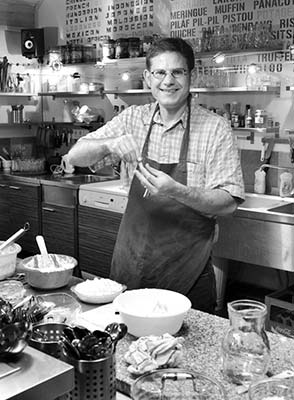
In the late 19th century, a vibrant café culture boomed here in Budapest, just as it did in Vienna and Paris. The kávéház (“coffeehouse”) was a local institution. By 1900, Budapest had more than 600 cafés. In this crowded and fast-growing cityscape, a neighborhood café allowed urbanites to escape their tiny flats (or get a jolt of caffeine to power them through a 12-hour workday). Local people (many of whom had moved to the city from the countryside) didn’t want to pay to heat their homes during the day. So instead, for the price of a cup of coffee, they could come to a café to enjoy warmth, companionship, and loaner newspapers.
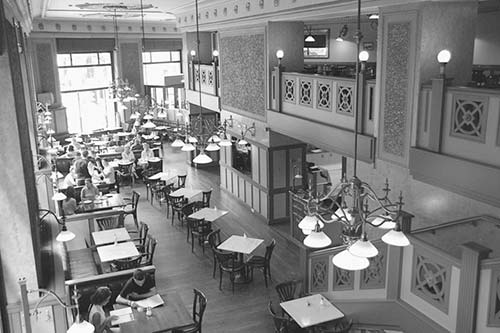
Realizing that these neighborhood living rooms were breeding grounds for dissidents, the communists closed the cafés or converted them into eszpresszós (with uncomfortable stools instead of easy chairs) or bisztrós (stand-up fast-food joints with no chairs at all). Today, nostalgia is bringing back the kávéház culture—both as a place to get coffee and food, and as a social institution. While some serve only coffee and cakes, most serve light meals, and some serve full meals (as noted below).
On the Great Boulevard: New York Café makes the others listed here look like Starbucks. Originally built in 1894 as part of the “New York Palace” (and it really is palatial), this fanciful, over-the-top explosion of Neo-Baroque and Neo-Renaissance epitomizes the “mix and match, but plenty of everything” Historicist style of the day. In the early 20th century, artists, writers, and musicians came here to sip overpriced coffee and bask in opulence. After decades of neglect, Italian investors completely restored it in 2006, and now it once again welcomes guests. You’ll be met at the door and asked if you want a table; they’ll typically let you gape at the inside for a few minutes if you ask nicely, but only paying customers may take photos. The food is drastically overpriced and disappointing—don’t bother eating a meal here, but do consider coffee and cake. If you’re up for a coffee break, this place might actually be worth an $8 cup of coffee. Be sure to read the fun history in the menu (4,000-6,500-Ft main dishes, 1,000-1,500-Ft coffee and hot chocolate drinks, 1,800-2,300-Ft desserts). While it’s a few blocks beyond the tourist zone, it’s worth the trip out here for the ultimate in turn-of-the-20th-century Budapest elegance (daily 9:00-24:00, inside the Boscolo Hotel at Erzsébet körút 9-11, district VII, tel. 1/886-6167). Take the M2/red Metró line to Blaha Lujza tér, and exit toward Erzsébet körút and walk a block. You can also take tram #4 or #6 from the Oktogon (at Andrássy út) around the Great Boulevard to the Wesselényi utca stop. For location, see the color map at the front of this book.
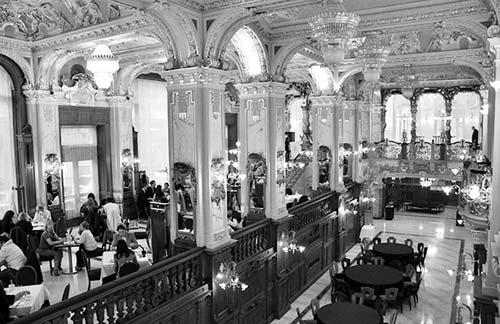
Two blocks up from Váci utca: Gerlóczy Café, listed as a restaurant on here, nicely recaptures Budapest’s early-1900s ambience, with loaner newspapers on racks and a management that encourages loitering. Nearby, another good choice for coffee and cakes is the similarly old-fashioned Centrál Kávéház. While the food here is pricey and hit-or-miss (don’t bother having a meal), it has an enjoyable and atmospheric two-story interior and a handy central location (daily 8:00-23:00, Károlyi Mihály utca 9, district V, M3: Ferenciek tere, tel. 1/266-2110). For location, see the map on here.
Near Ferenciek tere: Jégbüfé is where Pest urbanites get their quick, cheap, stand-at-a-counter fix of coffee and cakes. And for those feeling nostalgic for the communist days, little has changed at this typical bisztró. First, choose what you want at the counter. Then explain it to the cashier across the aisle. Finally, take your receipt back to the appropriate part of the counter (figure out the four different zones: coffee, soft drinks, ice cream, cakes), trade your receipt for your goodie, go to the bar, and enjoy it standing up (cakes for under 400 Ft, Mon-Sat 7:00-21:30, Wed until 20:30, Sun 8:00-21:30, Ferenciek tere 10, district V, M3: Ferenciek tere—for location, see the map on here). Not sure what to get? Here are some traditional Hungarian favorites: krémes (KRAY-mesh) is custard sandwiched between delicate wafers. Rákóczi turós (RAH-koht-see TOO-rohsh) is a cake of sweet cottage cheese (a Hungarian dessert staple) with jam on top. Dobos torta (DOH-bohsh TOR-taw) has alternating layers of chocolate and vanilla cake topped with caramelized sugar. Somlói galuska (SHOM-lowee GAW-losh-kaw) is made of pieces of moist sponge cake soaked in rum and drizzled with chocolate. And flódni (FLOHD-nee)—in the pie section (in this area, you can pay directly at the counter)—has layers of nut paste and poppy seeds...another Hungarian dessert staple. For a simpler procedure, get in line at the waffle (gofry) window facing the street, where you can pay cash for a steaming-hot Belgian waffle with toppings (window open daily 10:00-18:00).
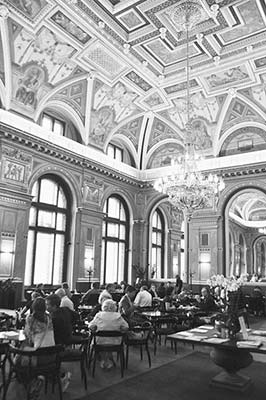
On Andrássy út, near the Opera House: Three fine and very different cafés are within a block of the Opera (for locations, see the map on here). The Alexandra bookstore—in the Lotz Hall of the newly refurbished Párisi Nagy Áruház (Paris Department Store)—hides a spectacular gilded café that immerses you in turn-of-the-century splendor (walk straight in and go up the escalator). Because this prominent local chain encourages loitering, the service here is no-pressure, and the drinks and desserts are bargain-priced (600-1,000-Ft coffee drinks and cakes). Rounding out this café’s appeal are the occasional live piano music, periodic evening concerts, and mirrors at either end that make the hall seem to go on forever (daily 10:00-22:00, can close unexpectedly for private events, Andrássy út 39, district VI, M1: Opera, tel. 1/461-5835). Callas features ideal outdoor seating facing the Opera House, and one of the finest Art Nouveau interiors in town, with gorgeous Jugendstil chandeliers. While their full meals are pricey (4,000-5,000 Ft), this is a wonderful spot on Andrássy út for a coffee break, a tasty dessert, or breakfast (ham and eggs plus coffee for around 2,000 Ft, 800-Ft pastries; daily 10:00-24:00, Andrássy út 20, district VI, M1: Opera, tel. 1/354-0954). Across the street and a block toward the Oktogon, Művész Kávéház (“Artists Coffee House”) is a classic café with 19th-century elegance, a hoity-toity high-ceilinged interior, snobby staff, and fine outdoor seating on Andrássy út. True to its name, this institution in the “Broadway Quarter” is a favorite after-rehearsal haunt of locally famous actors and musicians (700-900-Ft cakes, 1,500-Ft sandwiches, 3,400-Ft main dishes, 900-1,600-Ft breakfasts, Mon-Sat 9:00-22:00, Sun 10:00-22:00, Andrássy út 29, district VI, M1: Opera, tel. 1/333-2116).
In Buda, atop Castle Hill: Ruszwurm lays claim to being Budapest’s oldest café (since 1827). Tiny but classy, with old-style Biedermeier furnishings and fine sidewalk seating, it upholds its venerable reputation with pride. Its dead-central location—a block in front of Matthias Church in the heart of the castle district—means that it has become a popular tourist spot (though it remains dear to locals’ hearts). Look for gussied-up locals chatting here after the 10:00 Sunday-morning Mass at the church (700-Ft coffees, 400-600-Ft desserts, daily 10:00-19:00, Szentháromság utca 7, district I, for location see map on here, tel. 1/375-5284).